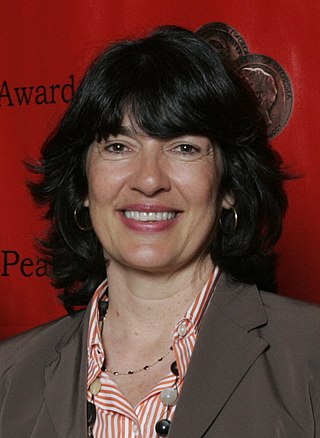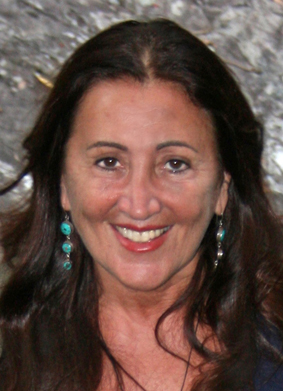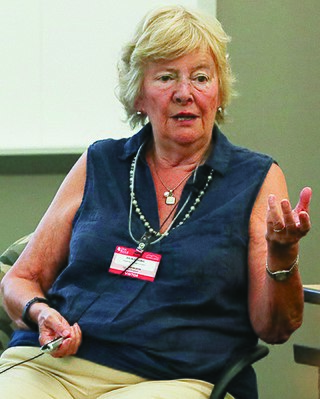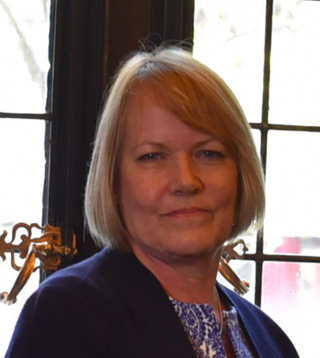
Geomorphology is the scientific study of the origin and evolution of topographic and bathymetric features generated by physical, chemical or biological processes operating at or near Earth's surface. Geomorphologists seek to understand why landscapes look the way they do, to understand landform and terrain history and dynamics and to predict changes through a combination of field observations, physical experiments and numerical modeling. Geomorphologists work within disciplines such as physical geography, geology, geodesy, engineering geology, archaeology, climatology, and geotechnical engineering. This broad base of interests contributes to many research styles and interests within the field.

Christiane Maria Heideh Amanpour is a British-Iranian journalist and television host. Amanpour is the Chief International Anchor for CNN and host of CNN International's nightly interview program Amanpour and CNN's The Amanpour Hour on Saturdays. She is also the host of Amanpour & Company on PBS.

Lynne Joanne Franks is a communications strategist and writer. She founded a public relations consultancy in the early 1970s.
Environmental archaeology is a sub-field of archaeology which emerged in 1970s and is the science of reconstructing the relationships between past societies and the environments they lived in. The field represents an archaeological-palaeoecological approach to studying the palaeoenvironment through the methods of human palaeoecology. Reconstructing past environments and past peoples' relationships and interactions with the landscapes they inhabited provides archaeologists with insights into the origin and evolution of anthropogenic environments, and prehistoric adaptations and economic practices.

Dame Julia Stretton Higgins is a British polymer scientist. Since 1976 she has been based at the Department of Chemical Engineering at Imperial College London, where she is emeritus professor and senior research investigator.

Karl W. Butzer was a German-born American geographer, ecologist, and archaeologist. He received two degrees at McGill University, Montreal: the B.Sc. (hons) in Mathematics in 1954 and later his master's degree in Meteorology and Geography. Afterwards in the 1950s he returned to Germany to the University of Bonn to obtain a doctorate in physical geography. He obtained a master's degree in Meteorology and Geography from McGill University and a doctorate in physical geography from the University of Bonn in Germany.

Professor Dame Jane Elizabeth Francis, is the Director of the British Antarctic Survey. She previously worked as Professor of Palaeoclimatology at the University of Leeds where she also was Dean of the Faculty of Environment. In 2002 she was the fourth woman to receive the Polar Medal for outstanding contribution to British polar research. She is currently the Chancellor of the University of Leeds.

Dame Athene Margaret Donald is a British physicist. She is Professor Emerita of Experimental Physics at the University of Cambridge, and Master of Churchill College, Cambridge.

Professor Dame Linda Partridge is a British geneticist, who studies the biology and genetics of ageing (biogerontology) and age-related diseases, such as Alzheimer's disease and Parkinson's disease. Partridge is currently Weldon Professor of Biometry at the Institute of Healthy Ageing, Research Department of Genetics, Evolution and Environment, University College London, and the Founding Director Emeritus of the Max Planck Institute for the Biology of Ageing in Cologne, Germany.
Mary Lou Zoback is an American geophysicist and seismologist. A specialist in tectonic stress and natural hazards risks, she spent most of her career as a research scientist with the United States Geological Survey. Zoback chaired the World Stress Map project of the International Lithosphere Program from 1986 to 1992. Zoback served on the U.S. Nuclear Waste Technical Review Board from 2012 to 2018.
The Women of Outstanding Achievement Photographic Exhibition was an annual event organised by the UKRC between 2006 and 2012, when it was subsumed into the WISE Campaign awards. It comprised creative photographs of outstanding women within science, engineering and technology (SET). Between four and seven women were chosen each year to be photographed by Robert Taylor. Nominations occurred in the Autumn of each year and the recipients were announced at a ceremony in March of the following year.

Karen Kohanowich is a retired U.S. Naval officer and ocean research and technology program manager for the National Oceanic and Atmospheric Administration (NOAA)'s Office of Ocean Exploration and Research (OER). She was NOAA's Acting Director of the National Undersea Research Program (NURP) from 2006 to 2009, and served in various roles at OER, including Acting Deputy and Undersea Technology director, until retiring in 2018. In July 2006, she became an aquanaut on the NASA Extreme Environment Mission Operations 10 crew.
Sharon Mosher is an American geologist. She did her undergraduate work at University of Illinois Urbana-Champaign. After earning an MSc from Brown University, she returned to the University of Illinois to get her PhD in Geology in 1978. Since 2001 she has held the William Stamps Farish Chair at University of Texas, and, since 2009 she has served as the dean of the Jackson School of Geosciences at Texas. In 2013 she became the president of the American Geosciences Institute.
Marie Morisawa was an American geomorphologist. Morisawa was an integral part of the revolution in the field that began in the 1950s. She studied the geomorphology of rivers, active fault zones, plate tectonics, coastal geomorphology, geological hazards, and environmental geomorphology.
Lynne Billard is an Australian statistician and professor at the University of Georgia, known for her statistics research, leadership, and advocacy for women in science. She has served as president of the American Statistical Association, and the International Biometric Society, one of a handful of people to have led both organizations.
Dame Helen Valerie Atkinson is Pro-Vice-Chancellor of Cranfield University's School of Aerospace, Transport and Manufacturing. She was previously Head of the University of Leicester's Department of Engineering and later Leicester's Graduate Dean. In 2010, she was designated one of the UKRC's Women of Outstanding Achievement and featured in the Women of Outstanding Achievement Photographic Exhibition. She was elected a fellow of the Royal Academy of Engineering in 2007, was a vice-president of the Academy from 2012 to 2014 and was elected to its Trustee Board in 2014.

Jane Anne Plant CBE, FREng, FRSE, FRSA (1945–2016) was a leading geochemist, scientist, and author. Plant was a pioneer in the field of geochemical surveys and environmental surveys. She was Chief Scientist at the British Geological Survey and was a Professor of Geochemistry at Imperial College London. Plant was also highly involved in the Institution of Mining & Metallurgy where she was involved in many aspects including a role on the Council, and was the first female President of the Institution of Mining & Metallurgy, a post she held from 2001 to 2002. This gave her an extensive network of key connections with government, industry and academia.
Doris Malkin Curtis was an American paleontologist, stratigrapher, and geologist. She became the first woman president of the Geological Society of America (1991) and made meaningful contributions to the Scripps Institution of Oceanography.
Suzanne Mahlburg Kay is the William & Katherine Snee Professor of Geological Sciences at Cornell University. She studies the origin and evolution of the continental crust. She is a Fellow of the Geological Society of America, the American Geophysical Union and the Mineralogical Society of America.

Wendy Matthews is a British archaeologist and academic, specialising in Neolithic and Bronze Age Near Eastern archaeology and Geoarchaeology. She is an associate professor at the University of Reading since October 2000.











